This post features the top five 10Gbps routers and Wi-Fi systems that I’ve evaluated. And 10Gbps is currently the highest wired bandwidth available for any home or small business—you could even call it “overkill.”
I’ve used all of these devices for an extended period—from over a month to over a year—with my 10Gbps Sonic Fiber-optic plan, and I’m still using some of them right now at various locations with multi-gigabit broadband. That’s to say they are really the top among their peers.
If you’re satisfied with the 2.5Gbps grade, this post on the best entry-level Multi-Gig solutions provides just-right options with better value for your money.
Dong’s note: I first published this post on May 2, 2024, and last updated it on June 19, 2025, to add more relevant information.

Top five best 10Gbps routers and Wi-Fi systems: The lists
Four things to keep in mind:
- There are two lists: one for standalone routers and the other for canned mesh systems. Most of the routers mentioned here can function as mesh members, and all the router units of the mesh systems mentioned here can operate as standalone routers.
- To qualify for this list, the bare minimum is that the hardware must have at least two 10Gbps ports—one for the WAN side and the other for the LAN. With the help of a 10Gbps switch and proper wiring, the entire home will have the highest possible bandwidth.
- Finally, these lists are sorted in recommendation order—the numbers are the ranking, with the number one being the best in my experience for my needs.
Notes on 10Gbps hardware
A router needs more than just a couple of 10Gbps Ethernet network ports to deliver (close to) true 10Gbps. It also requires high processing power and applicable firmware to handle this bandwidth.
Generally, consumer-grade Multi-Gig routers and switches do not deliver true 10Gbps (10,000Mbps) throughputs. After “overhead”, they sustain approximately between 6.5Gbps (Wi-Fi 6/6E hardware) and 8.5Gbps (Wi-Fi 7 hardware). Often, a router’s traffic-related features, such as QoS, security, etc., when turned on, can impact its bandwidth.
Many home Wi-Fi routers support the entry-level Multi-Gig, which is 2.5Gbps and can deliver close to 2,500Mbps in real-world speeds.
As usual, you should check each device’s full review to see how it pans out in detail, but if you’re in a hurry, any of them will do you a solid. Note that none of these routers will give you the actual 10Gbps performance in real-world usage, but they are indeed the fastest possible among consumer-grade options after overhead.
Let’s start with the routers.
Best 10Gbps routers: The ultimate list of top performers (and alternatives)
There are dozens of 10Gbps-capable routers on the market that I’d consider great, and picking only five out of them is challenging. That said, when applicable, I’ll include comparable alternatives worthy of your consideration. So, consider these five the representatives of their peers.
Top 5 best 10Gbps Multi-Gig routers
 |  |  |  |  | |
| Name | Ubiquiti Cloud Gateway Fiber (UCG-Fiber)’s Rating | Asus GT-BE98 Pro’s Rating | Ubiquiti UDM Pro Max’s Rating | TP-Link Archer GE800’s Rating | Netgear Nighthawk RS700S’ Rating |
| Price | – | – | – | – | – |
| Rating | |||||
| Description | |||||
| Statistics | |||||
| Buy this product |
5. Netgear Nighthawk RS700S: 2x 10GBASE-T

The Nighthawk RS700S is Netgear’s first standalone router with two Multi-Gig ports—both are 10GBASE-T. Despite its markedly different design, it has virtually the same hardware specs as the Asus RT-BE96U.
It’s the least recommended on this list due to its neutered web user interface. The omission of the standard and widely used web-based remote access feature alone is a deal-breaker for many advanced users. In fact, that was the reason I stopped using it after a month.
It’s also the sole router on this list that’s not mesh-capable—it works well only for homes where a single broadcaster is sufficient. Still, if you have 10Gbps broadband, the Netgear RS700S has enough to make you happy.
Netgear Nighthawk RS700S' Rating
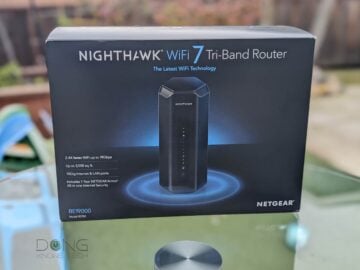
Pros
Top-tier tri-band specs with Wi-Fi 7 support
Two 10Gbps Multi-Gig ports
Robust web interface, helpful (optional) mobile app
Practical fan-less design; runs cool and quiet
Cons
Only two Multi-Gig ports; no standard Remote Management via Dynamic DNS
Online protection and Parental Controls require the Nighthawk mobile app and premium subscriptions
4. TP-Link Archer GE800: 1x 10GBASE-T, 1x 10GBASE-T/SFP+ combo, 4x 2.5GBASE-T

The Archer GE800 is TP-Link’s first actual gaming router. It’s a powerhouse with 7 specs of top-tier Wi-Fi and a multi-Gigabit approach, including two 10Gbps and four 2.5Gbps ports. This Wi-Fi machine is arguably the best standalone router TP-Link has ever made.
Similar alternatives:
- TP-Link Archer BE800: 2x 10GBASE-T (with SFP+ support) and 4x 2.5GBASE-T
- TP-Link Archer BE900: 2x 10GBASE-T (with SFP+ support) and 4x 2.5GBASE-T
- TP-Link Archer AXE300: 2x 10GBASE-T (with SFP+ support)
Need to make a quick shopping decision? Compare their prices on Amazon!
TP-Link Archer GE800's Rating
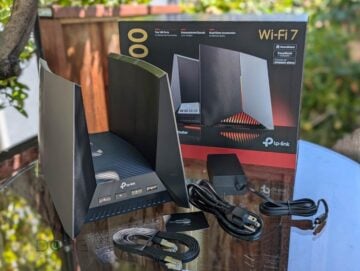
Pros
Top-tier tri-band Wi-Fi 7 specs with full multi-Gigabit to deliver excellent real-world performance
Robust web user interface with an excellent set of network features and Wi-Fi settings, including MLO and gaming-related features
Competitively priced; useful (optional) mobile app; EasyMesh-ready; cool-looking design
Cons
Bulky design with audible internal fan; runs hot; Wi-Fi throughputs could be comparatively a tad better
No AFC; online protection and advanced parental controls require subscriptions
Not wall-mount-ready
3. UniFi Dream Machine Pro Max (UDM Pro Max): The ultimate full-scale rackmount non-Wi-Fi router

The UDM Pro Max is a home-friendly, full-scale, non-Wi-Fi router designed for those with a network rack. With two 10Gbps ports, one 2.5Gbps port, and numerous Gigabit PoE ports, it’s ready to host a wide range of devices. The console also features two hard drive bays to accommodate terabytes of RAID1-protected storage space for its other functions.
Alternatively, you can also consider the similar UDM-SE, which has slightly lower hardware specifications and only a single drive bay.
Ubiquiti UDM Pro Max's Rating

Pros
Robust hardware to handle large-scale networks via multiple simultaneous enterprise-class applications; excellent overall performance
A complete set of useful networking features, including powerful security/web-filtering and WireGuard VPN; excellent web user interface; useful mobile apps
Dual drive support with RAID 1; no subscription required; runs relatively cool and quiet
Cons
Bulky design with only two SFP+ (10Gbps) and one 2.5GBASE-T ports, no 10GBASE-T port, no PoE support
A Ubiquiti login account is required for some useful features to work
2. Asus GT-BE98 Pro: 2x 10GBASE-T and 4x 2.5GBASE-T

The GT-BE98 Pro is Asus’s second Wi-Fi 7 router, the first being the RT-BE96U. It has two 10Gbps and four 2.5Gbps ports. Users can use them in various roles and configurations, including WAN, LAN, Link Aggregation, and Dual-WAN.Like all Asus routers, the Asus GT-BE98 Pro is also AiMesh-ready.
Similar alternative:
- Asus RT-BE96U: 2x 10BASE-T ports
- Asus RT-BE88U: 1x 10GBASE-T, 1x SFP+ and 4x 2.5GBASE-T
- Asus GT-AXE16000: 2x 10GBASE-T ports
- Asus RT-AX89X: 1x 10GBASE-T and 1x SFP+
Not sure which to pick between the above? Compare availability on Amazon!
Asus GT-BE98 Pro's Rating
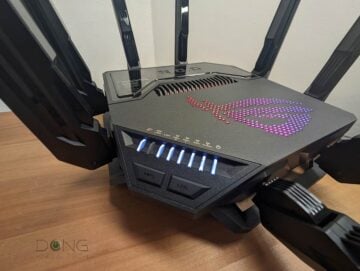
Pros
Quad-band with top-tier Wi-Fi 7 support and excellent real-world performance
Lots of free, in-depth, and valuable networking features and settings (VPN, AiProtection, Parental Control, Guest Network Pro, Bandwidth monitoring, etc.); tons of gaming-related features; AiMesh-ready
Two 10Gbps and four 2.5Gbps Multi-Gig ports with WAN/LAN flexibility; supports Dual-WAN and LAN/WAN Link Aggregations
No vendor required login account; fanless design; silent performer
Cons
Bulky design; lots of plastic wraps
MLO and AFC not available at launch
Unavailable outside of America
1. Ubiquiti UniFi Cloud Gateway Fiber (UCG-Fiber): 1x 10GBASE-T, 2x SFP+, 4x 2.5GBASE-T

Like the UDM Pro Max above, UniFi Cloud Gateway Fiber is a non-Wi-Fi router. You can add one or a couple of UniFi access points to create a robust mesh system.
The UCG-Fiber has two SFP+ ports, one 10GBASE-T port, and four 2.5GBASE-T ports, making it one of the most generous Multi-Gig routers, port-wise. It can handle a multi-Gigabit Dual-WAN setup while maintaining a 10Gbps local connection right out of the box.
Most importantly, it offers the most features and in-depth customization, yet comes with a well-thought-out management system that makes all users happy, from home to enterprise-class.
Similar alternatives:
- QNAP QHora-301W: 2x 10GBASE-T
- Amazon eero PoE Gateway: 2x 10GBASE-T and 8x 2.5GBASE-T
Need help deciding between these four? Check availability on Amazon!
Ubiquiti Cloud Gateway Fiber (UCG-Fiber)'s Rating

Pros
Top-tier hardware with three 10Gbps ports, four 2.5GBASE-T ports, PoE+ support, and an NVMe slot for NVR
Excellent and reliable real-world performance; can handle lots of concurrent UniFi devices (Wi-Fi access points, cameras, IP phones, etc.) and end-users
Compact and aesthetically pleasant design with everything for all users, from home to enterprise-grade
Lots of valuable features, each with tons of customization, comparatively affordable
Cons
Only one PoE+ port, no PoE++ support; SFP+ ports are less practical than 10GBASE-T
A Ubiquiti login account is required for the built-in Remote Management, as well as some other useful features, to work
Runs a bit warm, no SSD caddy is included in the non-storage version; no USB port or network-attached storage features
Best 10Gbps Wi-Fi systems: The current list of top performers
Currently, there are fewer than 10Gbps-capable mesh systems on the market than standard routers. That said, the list below includes all those that qualify. Not all of them are better in terms of features and privacy than when you get a couple of mesh-capable routers on the list above together. Still, on the wired networking front, they are all formidable contenders that will give you the best performance currently available.
Top 5 best 10Gbps Multi-Gig mesh systems
 |  |  |  |  | |
| Name | Ubiquiti UniFi-Based Wi-Fi System’s Rating | Asus ZenWiFi BQ16 Pro’s Rating | Asus ZenWiFi BT10’s Ratings | TP-Link Deco BE85’s Rating | Netgear Orbi 970 Series (RBE973S)’s Rating |
| Price | – | – | – | – | – |
| Rating | |||||
| Description | |||||
| Statistics | |||||
| Buy this product |
5. Netgear Orbi 970 series (Wi-Fi 7): 2x 10GBASE-T + 4x 2.5GBASE-T (router) / 1x 10GBASE-T + 2x 2.5GBASE-T (satellite)

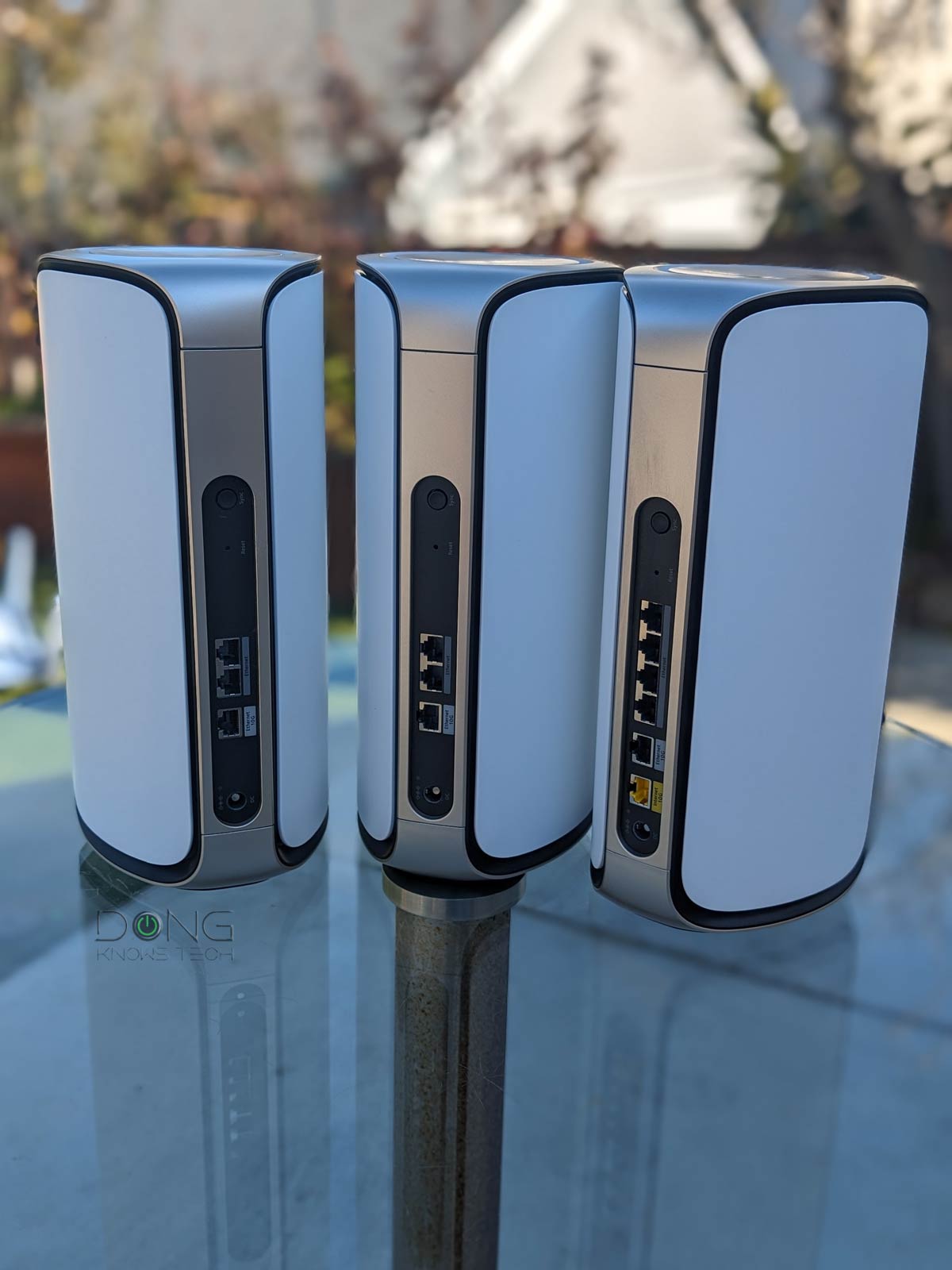
The 970 series is Netgear’s latest Orbi mesh set and also the company’s first canned system to feature Wi-Fi 7 and full Multi-Gig. The hardware does not have a Gigabit port. Unfortunately, unlike the TP-Link BE85 below, the satellite unit has only one 10Gbps port, meaning you’ll need a switch before you can get a true 10Gbps wired backhauling system with it.
Netgear Orbi 970 Series (RBE973S)'s Rating

Pros
Powerful hardware with quad-band Wi-Fi 7 with all-Multi-Gig ports
Fast performance, extensive coverage, with excellent wireless backhaul bandwidth
Multi-Gigabit wired backhauling support; easy to use; runs cool and quiet
Cons
Unreasonably expensive; the permanent 5GHz backhaul band is unavailable to clients in a wired backhaul setup
No web-based Remote Management, limited Wi-Fi and network settings, few free features; mobile app (with a login account and even subscriptions) is required to be useful
No 2nd 10Gbps port on the satellite; unreliable (at launch); no USB port; lots of upselling pop-ups
4. TP-Link Deco BE85 (Wi-Fi 7): 2x 10GBASE-T and 2x 2.5GBASE-T
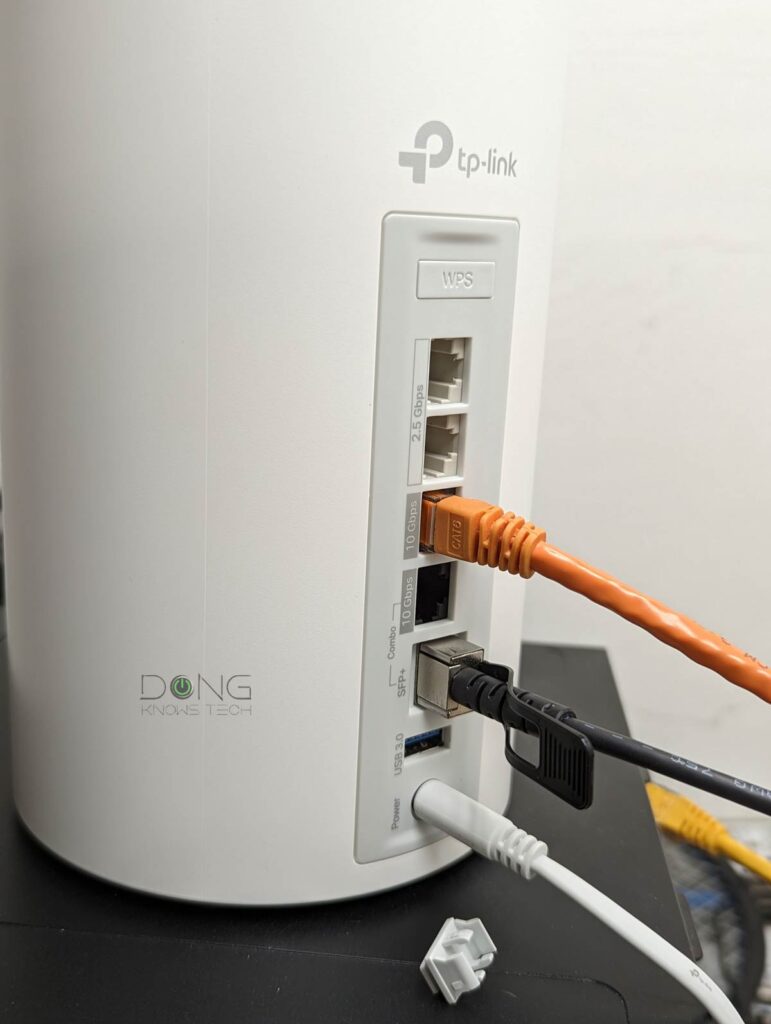
The Deco BE85 forgoes Gigabit ports altogether. Instead, it comes with two 10GBASE-T ports (one is an SFP+/RJ45 combo) and two 2.5GBASE-T ports. With them, this 3-pack mesh is the best-performing Wi-Fi solution to date via wired backhauling.
Alternatively, you can also consider the Deco BE95.
TP-Link Deco BE85's Rating

Pros
Four Multi-Gig ports, including two 10 Gbps, one of which supports RJ45/SFP+ combo; multi-Gigabit wired backhauling out of the box
Wi-Fi 7 support, backward compatible with existing clients; excellent overall real-world performance
Easy to use
Cons
The performance of the 2.4 GHz band and 10Gbps ports could be better
Vendor-connected mobile app required; HomeShield Pro costs extra
Internal fan; runs a bit hot
3. Asus ZenWiFi BT10 (Wi-Fi 7): 2x 10GBASE-T


The ZenWiFi BT10 is the tri-band version of the BQ16 Pro below and the second in the family to feature Wi-Fi 7. This 2-pack mesh had a rough start when it was first launched in July 2024. It wasn’t until November that a well-developed version of firmware was available to make it a formidable alternative to its superior cousin.
If you have a wired home, this is an excellent Wi-Fi 7 upgrade.
Asus ZenWiFi BT10's Ratings

Pros
Tri-band Wi-Fi 7 with two 10Gbps ports and excellent performance
ASUSWRT 5.0 has lots of customizations and free-for-life high-end features (VPN, Parental Controls, Online Protection, Dual-WAN, Link Aggregation, Smart Home Master, etc.).
Robust web user interface and helpful optional mobile app; easy-to-blend-in design
Comparatively compact with no internal fan; runs cool and quiet
Cons
Only three network ports
No AFC (at launch); not wall-mount-ready
2. Asus ZenWiFi BQ16 Pro (Wi-Fi 7): 2x 10GBASE-T


The ZenWiFi BQ16 Pro is the first in Asus’s ZenWiFi family to support Wi-Fi 7. Most importantly, it’s also the first to deliver Wi-Fi 7 in all its glory, including the fact that it’s the first to support the AFC feature and be the most powerful canned mesh system to date.
The new mesh system is available in packs and two or three units with a single unit option to come. Each unit can work as a standalone router.
Asus ZenWiFi BQ16 Pro's Rating

Pros
Top quad-band Wi-Fi 7 specs with all features to deliver best-to-date real-world performance both in throughputs and coverage; two 10Gbps Multi-Gig ports
The latest ASUSWRT 5.0 has lots of customizations and free-for-life high-end features (VPN, Parental Controls, Online Protection, Dual-WAN, Link Aggregation, Smart Home Master, etc.).
Robust web user interface and helpful optional mobile app; easy-to-blend-in design
Comparatively compact with no internal fan
Cons
Comparatively expensive; numerous settings require a lengthy restart to apply
Only two Multi-Gig ports; AFC still pending certification (by early 2025)
Not wall-mount-ready
1. Ubiquiti UniFi-based Wi-Fi system: 2x SFP+, (1x 10GBASE-T,) and multiple 2.5Gbps ports

A UniFi-based mesh Wi-Fi system is not available as a “canned” solution. You’ll need to start with a 10Gbps-capable gateway, such as:
and then add a couple or more 10Gbps-capable UniFi access points, such as:
to build a system. In return, it’ll give you the most robust network with the best performance and top-notch feature set.
Ubiquiti UniFi-Based Wi-Fi System's Rating

Pros
Excellent and reliable performance with seamless support for UniFi hardware of multiple categories (Network, Protect, Talk, Access, etc.)
Tons of helpful networking features, a comprehensive web user interface, and a mobile app
Practical and aesthetically pleasing hardware design, no vendor account required
Cons
No AP mode as a system, most Wi-Fi-integrated consoles can only work in the primary router role
Some helpful features (teleport VPN, automatic backup, convenient remote access, etc.) require a vendor-connected login account
The takeaway
“Money is not an issue. Just tell me the best router/mesh system to buy!” is the request I often receive—if only it were that easy.
Networking, whether in real life or technology, is always a matter of nuance, and individual needs vary significantly. In most cases, you need to figure that out first, and only then will money help.
However, if you have 10Gbps broadband, any of the hardware options above will yield the best real-world performance, at least at the router unit and especially via a wired connection. If you’re still not happy, check your device or maybe your expectations first.



Excellent review, I agree with your rankings and the reasoning behind them; UCG-Fiber and U7 Pro XGS is the way to go.
My only quibble is that I would rate the Asus RT-BE96U higher than the GT-BE98 Pro because it doesn’t split the 6 GHz band. The ’96 supports 3 320 Mhz channels while the ’98 only provides 2.
As a single router, I’d take the 98 Pro over the 96U, Richard, but the two are similar.
I know this is an older post, but how are the parental control options on Ubiquity setups? I understand I can setup VLANs and a separate WiFi network for the kids, but you need to log into the system via your PC to make all the changes, right? Or is there an app where you can manage this on your phone too?
I have a Deco BE85 WiFi 7 system now and when it works, it works great. The problem is it is not reliable. Devices drop often and parental control functions sometimes stop working. But when it is working, having features like allowing extra screen time through the app and turning downtime on/off is really great. It is also convenient being able to control these features remotely while I am away at work.
Does Ubiquity offer this kind of convenience?
1. This is not an “older post”. It’s as updated as can be. Unlike other online media, I don’t artificially change the date to make the information seem “fresh”.
2. Everything you want from a home router you’ll get it from a UniFi console and MUCH more. More here. There’s no comparison.
3. Make sure you actually *read*.
Thanks for the review, Dong. Excellent as always. So does everyone enable MLO on the GT-BE98? Is it worth it? Looks like the SSID’s all wrap back into one?
I’d say it’s not worth it, Joey. Give this portion of the post on the standard a good read.
Thanks Dong. I ended up setting it up prior to your recommendation, and I found it not to be worth it – I do like keeping the SSID’s separated.
Which is another thing, it looks like the smart connect is now the default when setting up a new Asus network – frustrating to say the least.
On a more positive note, I am running 2 GT-BE98’s and two satellite BQ16 Pro’s with a XS1930-12HP switch in between – and man, I think I found the absolute perfect setup!
That’s expensive, Joey! I have a similar setup but with a single GT-BE98 Pro and a 2-pack BQ16 for future AiMesh-related posts and thought I’ve been rolling VIP. Thanks for sharing and cheers! 🙂
That’s the setup I am building now. Two bq16 pro and 1 gt-be98 pro probably as well. All hardwired of course. Great guide thank you!
With the latest firmware (for both), Sev, the combo will work well, and it’ll top-notched via wired backhauling. Good luck!
i am interested ina 10gbps router without wlan, thanks!
seems there are not many options available at the moment.
That’s the #1 in this list. And you can turn Wi-Fi off on the rest by the way.
I’m surprised you included the UDM-SE but not the TP-Link ER8411. I’ve found TP-Link’s firmware to be more reliable that Ubiquiti’s.
The main downside of the ER8411 is that it just has 2 x 10Gbps ports (SFP+) and 8 x 1Gbps ports. No 2.5Gbps. That’s fine for me since I have a MikroTik switch with 12 x 10Gbps ports.
I haven’t tested the TP- Link, and I can’t test every router. The Unifi OS has so much more, tho.
Firewalla, mine has been rock solid and never had an issue. Can’t recommend it enough.
I find Firewalla’s firmware to be a bit limited in features and bloated with unnecessary options and notifications, Tank. I stopped using the Gold after less than a month. It got old fast.
For the cost of the Gold Pro, any routers mentioned here is 10x better.
What about the TP-Link ER8411? At the prices of any one of these routers. This should be considered as well.
I haven’t tried it. It looks like a router with a built-in Omada controller. Looks decent for sure.
I am thinking about switching over to this. Because I need a backup or failover Wan and qhora refuses to do this. They only offer a broken load balancing. And I already have omada EAPs and a controller. Might as well complete the system I guess. Unless there is something that is not great with this unit. Trying to find unbiased opinions.
@Justin I’ve been using an ER8411 since its launch in November 2022, so around 18 months now. It works pretty well. I can get 8.4Gbps down in speed tests, which is the same as what I get if I connect my computer directly to the ONT.
My main complaint was the lack of a IPv6 firewall (it used to allow all inbound IPv6 connections!) but this was fixed in firmware v1.1.1 around six months ago.
How about Unifi Switch Flex XG? since it has multiple 10Gb ports, do you think that’s a good candidate?
Thanks,
Wilson
That’s a switch, Wilson, so it’s irrelevant. But you can use it with any router here, including the UDM-SE.
So I just got ATT fiber but I need a wifi extender with a Ethernet port to plug into my processor. What do you suggest? Thanks
It’s a bit cryptic what you said, DH. However, this post will likely help. Give it a good read. Good luck!
Still confusing but I need a WiFi extender with a Ethernet port cause my processor does not have WiFi capability.
Then what you need is a media bridge.
So looks like I need a booster with a Ethernet port. What’s my best option. Thanks
So is the asus rp-be58 my best option? Looks like it has a Ethernet port right?
It’ll work via the media bridge mode, but for it to be the “best,” you’ll need to have an Asus AiMesh-ready router. Generally, all Asus routers can work as a repeater (extender) or media bridge, by the way.
Now I’m thinking a mesh setup will be better. I could use better WiFi range for certain parts on my house but I need the Ethernet port to connect my 1 device to my network since it does not have a WiFi card. What do think and suggest?
Start with this post. Make sure you read and you’ll figure things out.
So looks like a WiFi mesh system.
I’m curious if you’ve had any experience with the Mikrotik switches, many of which can also do L3 routing (albeit much slower). Also do you have recommendations for NICs on the desktop side, specifically for Sonic’s 10Gbps plan?
Finally, what gear do you currently use for your 10Gbps Sonic plan? I’m on PGE so electricity consumption is a factor.
I have, but I find them a little behind the time. I talked in detail about my hardware in this post. Since then I’ve used all of these routers mentioned here with the current being the UDM- SE.
I mentioned their energy consumption in the reviews. Also on PG&E, by the way.
For MikroTik, you’d really want to get something from their router line (model numbers starting with CCR), not their switch line (CRS). The L3 offloading on the switches is mostly for inter-VLAN routing, with no NAT. It doesn’t support IPv6 routing well, and NAT slows it down quite a bit. The conntrack table is very small too, meaning the number of simultaneous connections that can take the “fast path”.